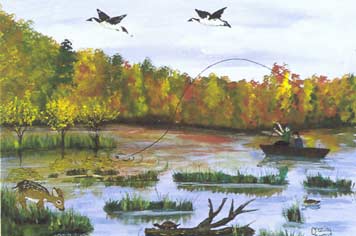The watershed approach
"When we try to pick out
anything by itself,
we find it hitched to everything else in the universe."
- John Muir
What is the Watershed Approach and why do we use it?
 A
"watershed approach" uses hydrologically defined areas (watersheds) to
coordinate the management of water resources. The approach is advantageous
because it considers all activities within a landscape that affect watershed
health. Ideally, a watershed approach will integrate biology, chemistry,
economics, and social considerations into decision-making. It considers local
stakeholder input and national and state goals and regulations. A watershed
approach recognizes needs for water supply, water quality, flood control,
navigation, hydropower generation, fisheries, biodiversity, habitat
preservation, and recreation - and it recognizes that these needs often compete.
It establishes local priorities in the context of national goals and coordinates
public and private actions. A watershed approach offers a blueprint for water
resource management.
A
"watershed approach" uses hydrologically defined areas (watersheds) to
coordinate the management of water resources. The approach is advantageous
because it considers all activities within a landscape that affect watershed
health. Ideally, a watershed approach will integrate biology, chemistry,
economics, and social considerations into decision-making. It considers local
stakeholder input and national and state goals and regulations. A watershed
approach recognizes needs for water supply, water quality, flood control,
navigation, hydropower generation, fisheries, biodiversity, habitat
preservation, and recreation - and it recognizes that these needs often compete.
It establishes local priorities in the context of national goals and coordinates
public and private actions. A watershed approach offers a blueprint for water
resource management.
A comprehensive watershed approach improves on the fragmented approach the nation has used in the past. The United States has developed separate laws for clean water, clean air, fertile soils, productive fisheries, healthy forests and robust communities. It created separate agencies to administer those laws at federal, state, and local 'levels and on public and private lands. These agencies have different missions, authorities, and modes of operation. The property boundaries of landowners and the political boundaries of states, tribes, counties, and municipalities are often unrelated to watershed boundaries. As a result, when citizens or governments have tried to coordinate water resource protection or restoration efforts, they have often found it difficult to do so. Evidence suggests that the watershed approach improves collaboration and information sharing among diverse partners and leveraging of resources.
Watershed Protection and Restoration
Watershed protection measures reduce impacts to waterbodies and prevent degradation. Protection measures include both voluntary and legally mandated actions. Paying farmers to set aside conservation easements, for example, ensures that some lands have limited human impacts, while water quality permits limit pollutant releases into waterbodies. Watershed protection measures that prevent degradation before it occurs typically cost less and succeed more often than watershed restoration measures implemented after watersheds are impaired. Protected watersheds are more likely to be healthier watersheds.
Watershed restoration is more difficult to define. Here are several possible definitions
- the manipulation of physical, chemical, or biological characteristic, with the goal of returning natural/historic functions.
- the "return of an ecosystem to a close approximation of its condition prior to disturbance."
- the reestablishment of pre-disturbance aquatic functions and related physical, chemical, and biological characteristics.
In summary, restoration activities seek to restore healthy aquatic communities and provide clean waters for recreation, irrigation, and public consumption.
For a more detailed discussion of watershed restoration principles, visit the Environmental EPA's "River Corridor and Wetland Restoration" webpage (http://www.epa.gov/owow/restore/).
Watershed restoration can be challenging. Most restoration efforts do not show immediate results. Some restoration activities can even unintentionally harm the environment. All restoration efforts require a long-term commitment.
Addressing Watershed Problems
A watershed approach highlights relationships among land management decisions, everyday actions, and watershed health. The next section of this report discusses threats to watershed health such as pathogens, chemical pollutants, and invasive species. Most are caused by commonplace activities: clearing forested lands for new housing developments; paving new roads and driveways for transportation; over-applying fertilizers and pesticides to lawns; overworking farmlands and timberlands; or postponing maintenance to home septic tanks. Only by understanding these problems and reducing our impacts can we assure healthy watersheds for our use and enjoyment.
This information was largely taken from EPA Office of Water publication Protecting and Restoring America's Watersheds, EPA-840-R-00-001.
Also see Watershed Protection -- An Introduction from EPA's Office of Wetlands, Oceans and Watersheds (OWOW)